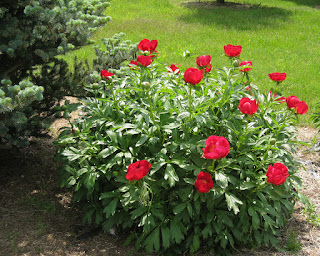This spring and summer I was obsessed with peonies, we have a large collection of species peonies in the garden that provide an incredible show every year. I started this season being obsessed with my trilliums but a humongous silver maple came crashing down in a freak 5 minute storm covering a large part of my trillium collection so that put a stop to that.
I will not be able to get that maple out of there till the ground is frozen; it would do too much damage to the plants, so in order to preserve my sanity (I needed a new obsession) the peonies got the attention that they deserve.
 |
| Paeonia suffruticosa ssp rockii |
 |
| Paeonia suffruticosa ssp rockii |
 |
| Paeonia suffruticosa ssp rockii |
 |
| Paeonia lactiflora |
Here at Arrowhead we had
always had an obsession with propagating plants by any means possible, that is
actually how we became a nursery, we simply had too many plants and needed to
sell some to make room for more and we needed money to buy more seed to make
more plants. Growing from seed was the first obsession and like so many other
gardeners we became seedaholics. We were so lucky that back 15-20 years ago
there was so many people collecting seed in the wild and sending out seedlists
every year, giving us the opportunity to grow plants from all over the world
that would otherwise not be possible.
One such seed collector was Joseph Halda
from Czechoslovakia, he traveled all over Europe and Asia collecting alpines
and many genera that had not been available for many, many years as wild
species. One such was the genus Paeonia.
 |
| Paeonia aff caucasica |
 |
| Paeonia veitchii |
 |
| Paeonia suffruticosa ssp rockii |
 |
| Paeonia caucasica |
 |
| Paeonia peregrina |
 |
| Paeonia caucasica |
 |
| Paeonia caucasica |
But about 6 or 7
years ago I had enough of caring for all those pots year after year and I made
Bob put them in the ground or sell them, he had a choice and he decided to have
them planted on two of our conifer berms that were planted only a few years ago
so the trees were still quite small and needed something to cheer them up.
So
about 200 Peonies were planted and I quickly forgot about them for most of the
year but every May and June I go back there and take some pictures. The first
few years were not so impressive, the conifers were small and the peonies were
small but they did produce some flowers every year and they were a good
opportunity for a photo shoot.
Then one year, I think it was 2012 I go back
there in May and the Peonies had outgrown the conifers and stole the show, it
was now a Peony berm and no longer a conifer berm.
Over the following years it just got better and better and by spring of 2016 the conifers had finally caught up with the Peonies. What a spectacular display!
This year I collected seed
of some of the nicest plants, best colors, and rarest species, and I would like
to offer them for sale.
At this point they are not pure wild type but first
generations in cultivation but since most species have their own bloom time they
will be true to type with a few surprises.
I also dug and divided
several plants and will offer divisions for sale this fall but there is of
course limited numbers and you should act quickly if there is a particular one
you really want.




















